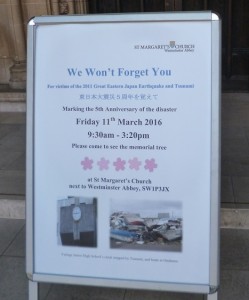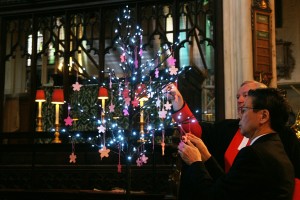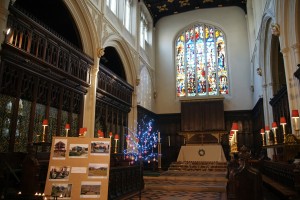Original Japanese written by staffer
The English below written and arranged by Heeday, based on the original Japanese
The English edited by Rev. Dr. Henry French, ELCA
The Year 5 Memorial Service of the 2011 Disaster of Eastern Japan was held on February 6th, 2016, at Southwark Cathedral, located close to London Bridge. (For another report on this service, please click here.)
Prior to the service every participant received a cherry blossom petal made of paper. On each petal, the name of a place was written where the March 2011 earthquake claimed one or more lives. This was a token of the participants’ firm determination to remember every casualty of the disaster, as well as their families and other victims who are still having a difficult time. All the participants attached their petals onto two cherry trees placed beside the altar. By the end of the service, the two trees came into full blossom, and were illuminated as a symbol of the light of hope.
Those cherry trees were then used, on March 11th, at the vigil at St. Margaret’s, Westminster Abbey. At the Abbey, they prayed for the victims of the March 2011 disaster during the hourly prayers.
*******************************
Below is a message from Yuki Johnson, who was a part of the organizing team for the Memorial Service.
“After I was chosen to be part of the preparation team for the Memorial Service, I thought about what we could do to remember the victims of the East Japan Earthquake at the service, and decided to ‘turn prayers into cherry blossoms.’
I heard that many cherry trees, affected by the tsunami, blossomed in April 2011, soon after the disaster, to comfort countless victims. When I first visited hard-hit areas of the earthquake and tsunami, in early in 2012, I had a cherry blossom viewing party with some residents of temporary housing in Onahama, Fukushima, and this gave me the basic idea. A certain refugee from Okuma Town, which was contaminated by fallout from the Fukushima Daiichi meltdown, woke up early on the morning of the cherry blossom viewing party and boiled a lot of rice for making many rice balls. He used a small rice boiler that had been donated as an aid item. Carrying the rice balls, many residents from the temporary housing, volunteers, and myself joined in the cherry blossom viewing party—a precious experience.
As I prepared the cherry petals, I prayed that we might have a vigil at a London church on the very day, March 11th. I consulted St. Paul’s Cathedral, but it was already booked with another scheduled event. Then, Bishop Michael Ipgrave advised me to contact Westminster Abbey, where I was told that we could have the vigil in the middle of February, 2016. This did not leave us much time for preparation. Still, many people from my Japanese-speaking church in the UK, as well as their friends, helped us successfully prepare for the vigil.
First, Ambassador Hayashi came to the vigil, followed by many members of the Japan Society in the UK, and its subgroup named “Koyo Kai.” The Fukushima People Association in the UK, as well as British citizens in London, some children and their dance instructors visiting London from Fukushima, and other travelers from Japan and other countries joined in the vigil, presenting cherry blossom petals, lighting candles, and offering prayers. The guides at Westminster Abbey joined in, one after another. Many of them thanked us for creating this opportunity.
Later, Ambassador Hayashi e-mailed Yuki, saying “Thank you for letting me join in the impressive vigil. I hope it gave consolation to many.”
Said Chizuru,”At the vigil, I saw countless people weeping, including a woman from Taiwan where many suffered an earthquake as well. That reminded me again of how deep their emotional wounds were. Also, I found that many young people outside of Japan were helping 2011 disaster victims. The vigil was an occasion of both tears and the people’s unity.”
Also, ”Someone expressed heartfelt words of thanks to me when he left the vigil. Possibly, he had suffered some tragedy in the 2011 disaster. I believe it was very meaningful that we had gathered for prayer across national borders. Many thanks to Yuki.”
Many participants wrote their messages in notebooks at the vigil, and we plan to bring them to the hard-hit areas this September. We intend to make them available for the public to read. All the messages are quite impressive. Quoted below are a few of them.
A visitor to London from Fukushima:
“I can never forget all those warm-hearted people helping us. Thanks to their help, I am alive today. Thank you!”
“Very sorry for your lost. Our souls crying with you”
“I pray for all the souls affected in this disaster. Thank you so much for offering this opportunity.”
Five years have passed since the East Japan Earthquake of March 2011. We now know, once again, that countless people are still suffering from a broken heart over the victims, not just in Japan, but here in the UK as well. At the vigil, we came together regardless of nationalities to share the sufferings of the victims of natural disasters and prayed together. I am very thankful to St. Margaret’s, Westminster Abbey, which kindly provided us with a place for the vigil.
Also, the hourly prayers at Westminster Abbey share some things in common with St. Margaret’s. So, the Abbey offered special prayers on the Year 5 commemoration of the East Japan Earthquake for the victims, for those helping them, and for the help provided by the Anglican-Episcopal Church in Japan. These prayers were also part of their collect of the day at evensong. Thanks!”
************************



